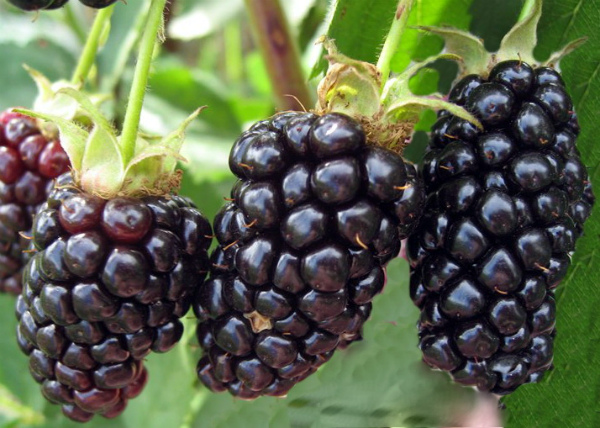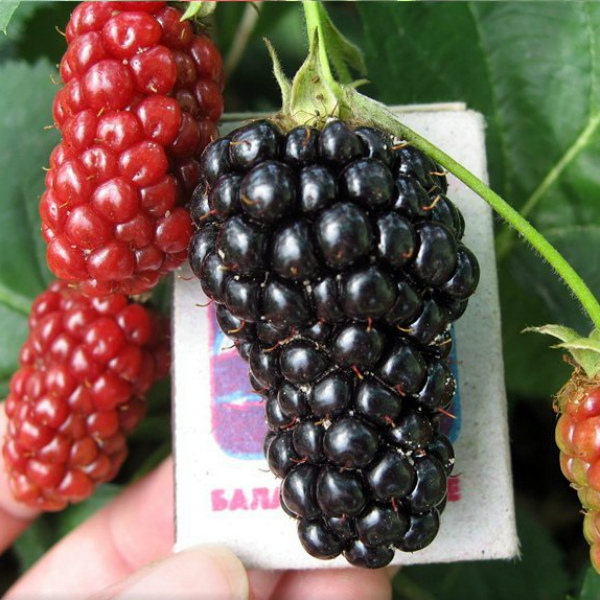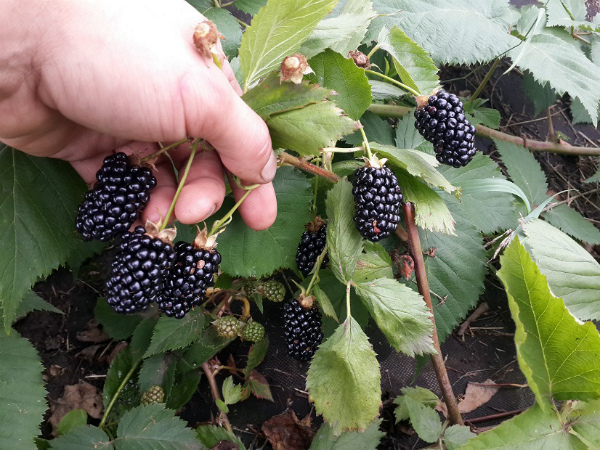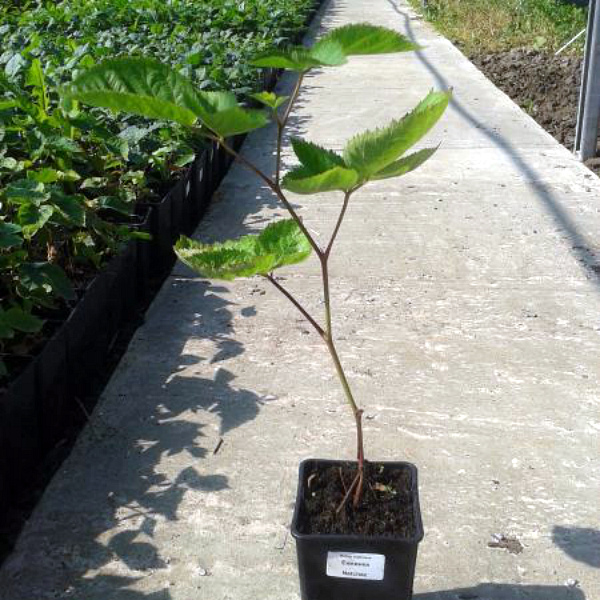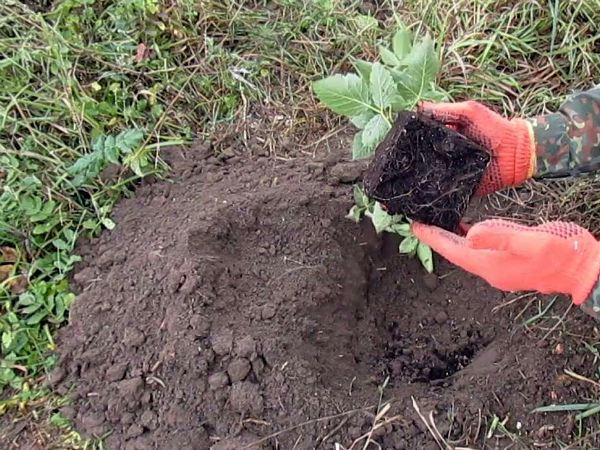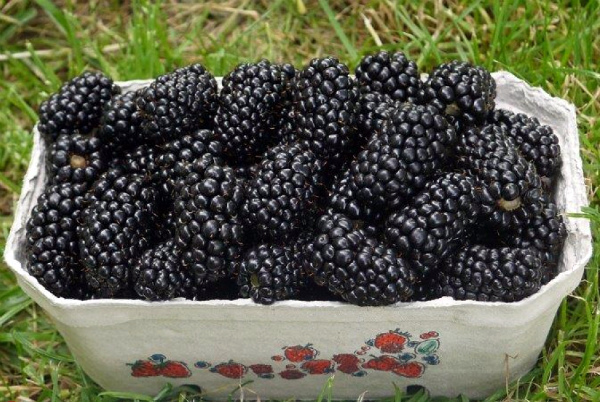Blackberry Natchez: description and characteristics of the variety
Content
Description and characteristics
The Natchez blackberry is one of the latest developments of American breeders. Work on the breeding of the variety lasted more than 6 years, and only in 2007 it was patented at the University of Arkansas by the famous breeder and author of the best blackberry varieties, John Clark. Natchez quickly won and has long maintained a leading position among the Western and European assortment due to the amazing taste and presentation of the berries.
According to the ripening period, it is considered super early. The berries reach their removable ripeness by the beginning of July, a couple of weeks earlier than other blackberry varieties. The fruiting period is extended - it lasts 3-5 weeks from the beginning of the collection of the first berries. Both the shrub and its fruits have a very colorful description: the plant is tall and vigorous (up to 6 m), during fruiting it literally bends under the weight of blackberry brushes.
“Natchez” is a creeping variety. At the very beginning of growth, the seedlings take a vertical direction, but upon reaching 4–5 meters they begin to bend and acquire the position characteristic of creeping plants. Blackberry seedlings grow very quickly; in the first year, powerful shoots with multiple stepchildren up to 3-4 meters high are formed on the plant. The bush blooms in the second half of May with simple white flowers, consisting of 5-6 petals.
Blackberries have an equally spectacular appearance - they are large, black, with a barely noticeable blue drupe of an elongated cylindrical shape. The taste is very sweet, even tart, with a subtle hint of acid and slight bitterness in the aftertaste. In technical maturity, the surface of the berries is shiny, when overripe it becomes slightly dull. Drupes are located on fruit branches in large clusters of 10-30 berries. They can hang on the bush for a long time, remaining dense and not crumbling.
The commercial characteristics of the variety are very high. In addition to a delicious multifaceted taste, Natchez blackberries are distinguished by impressive fruit sizes.
Berries from the first harvest are 3-4 cm long and weigh 9-15 g, but with each subsequent harvest the size and weight of the fruits increases, and can reach 5-6 cm with a weight of 20-22 g. This is a record weight indicator among the entire range of varieties blackberries.
The shrub bears fruit twice a season, so the total yield of the variety is high - 15–20 kg per bush. Despite their juiciness, the berries are well transported, and in a cool place they can be stored for up to 14 days.
Video "Natchez Blackberries"
Watch the Natchez blackberry video review and learn about the characteristics and benefits of this variety.
Advantages and disadvantages
According to gardeners, the Natchez blackberry is one of the best and most popular varieties for private and industrial cultivation. Such popularity of culture is due to its many advantages and positive qualities:
- excellent taste and presentation of the fruit;
- good transportability and preservation of berries;
- early ripening;
- extended period of fruiting (up to 6 weeks);
- high productivity (the formation of multiple clusters containing more than 2 dozen large berries allows you to collect high yields from a small area of land);
- the absence of thorns on the shoots, which greatly facilitates harvesting and caring for the crop;
- relatively high disease resistance.
The variety has much fewer drawbacks, but they also exist. First of all, it is low winter hardiness. The plant's root system can withstand temperatures down to -14 ° C, so it needs shelter for the winter. Also, the plant reacts badly to a sharp cold snap - a sudden drop in temperature to -15–20 ° C leads to freezing of the buds and, accordingly, a loss of yield next year.
Another disadvantage of the variety is the high demand of the crop for sunlight - the bush can please with a good yield only if it is planted in an open sunny area, where it is provided with proper care. In the shade, blackberries grow small, tart and not juicy enough.
Also, many gardeners note such a disadvantage as the fragility of the branches. The fact is that the shoots of the Natchez blackberry are already thinner than those of other varieties, and since the berries are of considerable weight, the branches often break off under their weight. To prevent this, it is necessary to install supports during the fruiting period, which somewhat complicates the care of the plants.
Landing features
In general, the Natchez variety is unpretentious in its content, but in order to achieve high yields in the future, blackberry seedlings must be planted correctly. The ideal soil for culture is fertile and well-drained sandy loam, loamy soil with neutral or low acidity. Poor soil with a low potassium content causes a change in the taste of the berries - they become sour and dry. The area where the seedlings will be planted should be well lit, but protected from winds and drafts.
The scheme according to which the crop is planted depends on the purpose of the cultivation. In an amateur garden, it is recommended to plant seedlings at a distance of 2.5–3 m - this is the optimal distance at which adult bushes will not interfere with each other. In industrial cultivation, it is permissible to place seedlings more densely (2–2.5 m). Since blackberries of this variety do not tolerate low temperatures, it is better to plant seedlings in spring, before bud break. In comfortable conditions, the plants will take root faster and survive the winter safely.
In order for the landing to be successful, it must be carried out in the following sequence:
- In a clean area, without weeds, stones and other debris, they dig a hole 40–45 cm wide and 0.5 m deep. If you plan to plant several bushes at the same time, then the holes are dug at a distance of at least 2.5 m.
- The top layer of the earth should be set aside, and the planting pit should be filled with a mixture of fertilizers (humus 5–6 kg, superphosphate 100 g, potassium salt 50-60 g).
- Then add a part of the soil to the hole and mix it with fertilizers.
- In this earthen mixture, make a depression and place the seedling vertically in it.
- Gently sprinkle the roots of the plant with earth, then compact it slightly.
- Form a hole around the bush, into which watering will be carried out and carefully pour 1-2 buckets of water into it.
- Then cut the seedlings to a height of 30 cm, and mulch the soil with a small (3-5 cm) layer of peat or humus.
Care
Agrotechnics of Natchez blackberry assumes care, which consists of a number of measures: watering, dressing, pruning, protection from diseases, pests and cold.
As already mentioned, when growing a crop, you have to use supports. It is better if the support structure is installed as early as possible - this will eliminate the need to support the branches during the fruiting period. The best option for blackberries are trellises up to 2 meters high. Young shoots are pinned to them, which release seedlings, and thus guide the plant.
Further care is as follows:
- Watering. Blackberries prefer moderately moist soil. Drought and stagnation of moisture are harmful for her, so watering should be done no more than 1 time a week at the rate of 3-4 buckets per bush. During the period of formation, the ovary is watered more often - every 2-3 days.
- Top dressing. Fertilizers are applied 3-4 times during the season. In early spring, before bud break - humus or compost 5–7 kg under a bush, 50 g saltpeter under a bush. During the growing season, a liquid mullein or dung is introduced (diluted with water in a ratio of 1:10). After fruiting, ash 500 g under a bush and superphosphate 100 g are embedded in the soil. Before the onset of frost, the trunks are mulched with organic matter.
- Pruning. Held once / 2 years. With the help of a pruner, old branches are removed, as well as some of the young ones - this allows you to maintain fruiting at the same level. All lateral branches are shortened by 20-30 cm.
- Diseases and pests. Since blackberries are resistant to these negative factors, care consists only in the preventive treatment of the bushes with Bordeaux liquid or tobacco dust.
- Shelter. The main care before wintering is to shelter the bushes from frost. Depending on the climate, you can cover with organic mulch (peat, sawdust, foliage, straw) or more reliable covering materials (film, agrofibre).
Harvesting
The timing of harvesting blackberries depends on climatic conditions. In warm regions, the beginning of fruiting occurs at the end of June, and in more severe conditions, berries ripen only by mid-July. The dark, almost black color of drupes is not yet a sign of their technical ripeness. As a rule, freshly colored berries are rather sour, so before picking them it is recommended to hold them on the bush for another 3-5 days in order to better reveal the taste and characteristic blackberry aroma.
Dried sepals and a slight separation of the berries testify to the full readiness of the fruits for collection.
Since the Natchez brambles are thornless, the harvesting process is a real pleasure. The average yield per bush is 13-16 kg, but proper care can increase productivity up to 20 kg or more. Blackberries of this variety are perfectly preserved and transported over long distances, for which farmers and gardeners love them so much. You can prepare any desserts, preparations, alcoholic drinks from berries, as well as freeze and dry.
It is no secret that blackberries contain a huge range of vitamins and nutrients that give it medicinal properties. And in order to have a vitamin product on your table regularly, plant blackberries in the garden and enjoy the excellent taste.
Video "Planting blackberries in open ground"
Thanks to this video, you can watch the process of planting a Natchez blackberry seedling in open ground.

